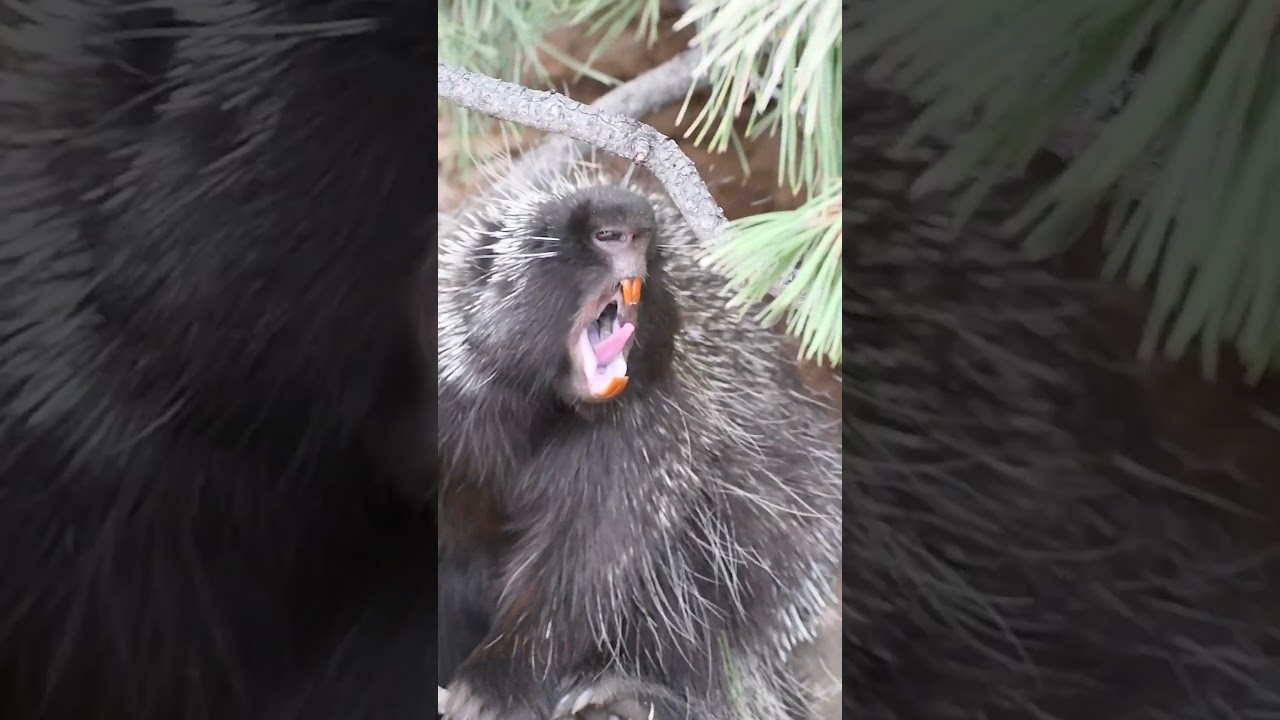- Biology and behavior of porcupines
- Unique adaptations and diet specifics
- Zoo management practices for porcupines
- Conservation status and efforts
- Importance of public awareness and education in wildlife conservation
Porcupines are fascinating creatures that belong to the mammalian class. These rodents are famous for their coats of sharp quills, their primary defense mechanism against predators. However, much more to their biology, behavior, and significance in the ecosystem is worth exploring in detail. One of the lesser-known yet intriguing aspects of porcupine behavior is yawning. Watching a porcupine yawn can provide an educational insight into their dental anatomy and overall health. For example, Roger, a porcupine at a zoo, offers an exceptional example of this.
Biology and Behavior of Porcupines
Porcupines belong to the family Erethizontidae in the New World and Hystricidae in the Old World. They are generally nocturnal and have a strong sense of smell, which helps them locate food and navigate their environment. The most distinguishing feature of porcupines is their quills. These are modified hairs coated with thick keratin plates, which can detach easily on contact and embed themselves in predators.
A porcupine’s a set of impressive chompers. These incisor teeth are essential for their survival, as they rely heavily on them for gnawing through tough plant material. The porcupine’s porcupine’s is adapted to its herbivorous diet, primarily consisting of bark, leaves, and stems. Their incisors grow continuously throughout their life, a characteristic feature of rodents.
Unique Adaptations and Diet Specifics
The yawning action provides a window into the porcupine, especially the incisors, which are self-sharpening; the harder enamel on the front wears down slower than the softer dentin at the back, maintaining a chisel-like edge. This adaptation is crucial for their feeding habits, which involve gnawing on various plant matter.
Porcupines are primarily herbivores, although their specific diet can vary based on their habitat. They consume various leaves, fruits, and bark; some species eat insects and small animals. Their nutritional intake is supplemented by geophagy, where they eat soil to obtain minerals like sodium and calcium that may be scarce in plant material.
Roger’s yawninRoger’sr’shlightaRoger’shlightscal aspect of porcupine biology: their respiratory and digestive systems. Like many other rodents, they have highly-specialized digestive systems that allow them to extract maximum nutrients from their rather fibrous diet. Understanding these physiological traits is essential in zoo management and wildlife conservation.
Zoo Management Practices for Porcupines
Caring for porcupines in a zoo setting, such as Roger’s, demands careful attention from zookeepers and veterinarians. Their enclosures need to mimic their natural habitats as closely as possible, featuring a variety of foliage and climbing structures. This enrichment is vital for their well-being, encouraging natural behaviors like foraging and climbing.
Feeding practices in zoos must ensure that porcupines receive a balanced diet that replicates their wild food sources. This often includes providing them various fruits, vegetables, and specially formulated rodent chow. Monitoring their dental health is also vital; the continuous growth of their incisors means they require regular opportunities to gnaw and wear down their teeth.
Through initiatives like educational programs and interactive exhibits, zoos play a pivotal role in raising public awareness about these remarkable animals. This public engagement helps foster a deeper appreciation for wildlife and the necessity of biodiversity.
Conservation Status and Efforts
While not generally considered endangered, porcupines face various threats in the wild. Habitat destruction, hunting, and vehicular accidents are some of the primary dangers to their populations. In some regions, porcupines are hunted for quills and meat, leading to localized declines.
Wildlife conservation efforts for porcupines involve habitat preservation, legal protection, and public education. By maintaining and protecting large swathes of forested areas, we can help sustain healthy porcupine populations. Legal protection against hunting and trading in certain regions ensures that these animals are not exploited. Efforts in public education, like those carried out in zoos, help build support for conservation initiatives among the general public.
Research into porcupine biology and behavior, supported by conservation organizations, contributes to our understanding and ability to protect these animals. This research includes studies on their population dynamics, habitat usage, and health, providing valuable data to inform conservation strategies.
Importance of Public Awareness and Education in Wildlife Conservation
Public awareness and educational initiatives are perhaps the most powerful tools for advancing wildlife conservation. Observing Roger yawn might seem simple, but it can spark curiosity and encourage individuals to learn more about these extraordinary creatures.
Zoos often serve as the first point of contact between the public and wildlife, making them ideal venues for educational outreach. By showcasing animals like Roger and explaining their characteristics, behaviors, and conservation needs, zoos can cultivate a sense of stewardship in their visitors.
Educational programs can include guided tours, interactive talks, and hands-on activities emphasizing wildlife programs that often inspire people to support conservation through donations, volunteer work, or adopting more sustainable lifestyles.
In summary, understanding the biology and behavior of porcupines, exemplified by Roger’s yawn, insights into their adaptive traits, dietary needs, and conservation status. Effective zoo management practices contribute significantly to their well-being and help foster a deeper public appreciation for these remarkable animals. By integrating research, conservation efforts, and public education, we can ensure the continued survival and prosperity of porcupine populations in the wild.
*****
Source Description


